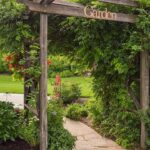Fencing on sloping gardens presents unique challenges and opportunities for homeowners. The combination of uneven terrain and the need for privacy or security can make choosing the right type of fence and designing its installation a bit tricky.
However, with the right knowledge and creativity, fencing on sloping gardens can enhance the overall aesthetic appeal of your outdoor space. In this article, we will explore various fencing ideas for sloping gardens, from choosing the right type of fence to creative design ideas, installation tips, landscaping incorporation, cost considerations, and long-term maintenance.
When it comes to fencing on sloping gardens, understanding the challenges is essential. The uneven terrain means that standard fencing options may not be suitable, requiring careful consideration of factors such as stability, aesthetics, and functionality. Choosing the right type of fence that complements the natural slope of your garden is crucial in achieving both practical and visually appealing results.
In addition to discussing creative design ideas for fencing on sloping gardens, we will also address tips for installing fences on such terrain. From overcoming specific challenges to incorporating landscaping elements with fencing and considering long-term maintenance costs, this article will provide comprehensive insights into making the most out of your sloping garden fencing project.
Choosing the Right Type of Fence for Sloping Gardens
When it comes to choosing the right type of fence for sloping gardens, there are a few key factors to consider. One important aspect is the slope of the terrain, as this will greatly impact the installation and overall functionality of the fence.
For steep slopes, a stepped or terraced fence design may be necessary to ensure stability and proper coverage. Additionally, considering the purpose of the fence, whether it’s for privacy, security, or purely decorative, will also influence the type of material and style that is best suited for the sloping garden.
For sloping gardens, one popular fencing option is a wire mesh fence. This type of fence is not only cost-effective but also easily conforms to the natural contours of a sloping garden. It can be installed with minimal disturbance to the existing landscape and offers good visibility while still providing a boundary for pets or children.
Another option for sloping gardens is a split rail fence made from wood or vinyl. This type of fence has a rustic charm and can complement the natural elements of a sloping garden while requiring minimal maintenance.
It’s important when choosing a fence for a sloping garden to also consider how it will integrate with landscaping elements such as plants, retaining walls, or hardscaping features. Using fencing as an opportunity to enhance and define outdoor spaces on different levels can create visual interest and improve functionality within a sloping garden. By carefully selecting materials and designs that complement the existing landscape, homeowners can achieve an aesthetically pleasing and cohesive look for their sloping gardens.
| Type of Fence | Best Suited Sloping Garden |
|---|---|
| Wire Mesh Fence | Easily conforms to natural contours; good visibility |
| Split Rail Fence | Rustic charm; complements natural elements; minimal maintenance |
Creative Design Ideas for Fencing on Sloping Gardens
When it comes to fencing ideas for sloping gardens, creativity is key. One popular option is to install a stepped fence, where the fence “steps” down with the natural slope of the garden.
This not only creates an interesting visual effect but also ensures that the fence remains level and sturdy. Another creative idea is to incorporate the fence into the garden design by using it as a support for climbing plants or incorporating decorative elements such as trellises or lattices.
For a more modern and contemporary look, consider using horizontal slat fencing. This type of fencing can be installed at an angle following the slope of the garden, creating a sleek and stylish design. Additionally, gabion walls – wire cages filled with stones – can be used as an alternative to traditional fencing on sloping gardens, providing a unique and textural element to the landscape.
In addition to considering the design and material of the fence, it’s also important to think about how lighting can be incorporated into the fencing for both safety and aesthetics. Solar-powered lights can be installed along the length of the fence, adding a soft glow to the garden in the evenings while also providing added security.
These are just a few examples of creative design ideas for fencing on sloping gardens, and with some careful planning and consideration, it’s possible to find a solution that works both practically and aesthetically.
| Design Ideas | Description |
|---|---|
| Stepped Fence | Fence “steps” down with natural slope for visual effect and stability. |
| Horizontal Slat Fencing | Sleek design that can be installed at an angle following slope for modern look. |
| Gabion Walls | Wire cages filled with stones create a textural alternative to traditional fencing. |
Tips for Installing Fencing on Sloping Terrain
Installing fencing on sloping terrain can be a challenging task, but with the right approach and techniques, it is definitely manageable. Here are some tips to consider when installing fencing on sloping gardens:
Surveying and Planning
Before you start installing your fence on a sloping garden, it’s crucial to conduct a thorough survey of the area. This will help you understand the degree of slope and any potential obstacles that may affect the installation process. Planning for the placement of fence posts and panels is essential to ensure a smooth and successful installation.
Use Adjustable Components
To accommodate the slope of your garden, consider using adjustable components for your fence such as swivel brackets, adjustable panels, or stepped panels. These components can be adjusted to follow the contour of the slope, providing a seamless look while maintaining the security and privacy of your garden.
Proper Anchoring and Support
When installing fencing on sloping terrain, proper anchoring and support are crucial for the stability and longevity of the fence. Make sure to use sturdy materials for posts and anchors to withstand the pressure from the slope. Additionally, consider adding diagonal bracing for extra support especially if you’re dealing with a significant slope.
By following these tips for installing fencing on sloping terrain, you can overcome the challenges associated with this type of landscape while creating a functional and visually appealing boundary for your garden.
Overcoming the Challenges of Fencing on Sloping Gardens
When it comes to fencing ideas for sloping gardens, there are unique challenges that homeowners must overcome in order to install a fence that is both functional and visually appealing. Sloping terrain can make it difficult to install traditional fencing, but with the right approach and some creativity, these challenges can be overcome.
Understanding the Challenges
One of the main challenges of fencing on sloping gardens is the uneven ground, which can make it difficult to achieve a level fence line. Additionally, the angle of the slope can create gaps underneath the fence, allowing small animals to pass through. It’s also important to consider erosion control and drainage when installing fencing on sloping terrain.
Choosing the Right Materials
When overcoming the challenges of fencing on sloping gardens, it’s crucial to choose the right type of materials. For example, choosing a flexible material such as chain link or wire mesh can help accommodate changes in elevation. Alternatively, using pre-assembled panels designed for uneven terrain can simplify installation.
Creative Solutions
One creative solution for fencing on sloping gardens is to step the fence down the slope in a series of terraced sections. This not only helps maintain a consistent height for the fence but can also create visual interest in the landscaping. Another idea is to incorporate landscaping elements such as retaining walls or planters into the design of the fence, further integrating it into the natural surroundings.
How to Incorporate Landscaping With Fencing on Sloping Gardens
When it comes to fencing ideas for sloping gardens, incorporating landscaping into the design is crucial to create a cohesive and visually appealing outdoor space. Here are some creative ways to integrate landscaping with fencing on sloping gardens:
1. Utilize terraced planters: One of the most effective ways to incorporate landscaping with fencing on a sloping garden is by using terraced planters. These can be built along the slope of the garden, allowing for different levels of planting to add texture and visual interest. Consider using a mix of shrubs, flowers, and even small trees to create a lush and vibrant backdrop for your fence.
2. Incorporate natural elements: Embrace the natural contours of the slope by incorporating natural elements such as rocks, boulders, or even a cascading water feature. These elements can not only add beauty to the landscape but also help in stabilizing the soil on the slope. Additionally, they can serve as focal points that complement the fencing design.
3. Select low-maintenance plants: When landscaping on a sloping garden with fencing, it’s important to choose plants that are low-maintenance and well-suited for the specific conditions of your garden. Look for varieties that are drought-tolerant, erosion-resistant, and can thrive in partial sun/shade depending on the orientation of your slope.
Incorporating landscaping with fencing on sloping gardens requires careful planning and design consideration. By implementing these creative ideas, you can enhance the overall aesthetics of your outdoor space while effectively addressing the challenges posed by sloping terrain.
Cost Considerations for Fencing on Sloping Gardens
When considering fencing ideas for sloping gardens, it is essential to factor in the cost considerations associated with this unique landscaping challenge. The cost of installing a fence on sloping terrain can vary greatly depending on various factors such as the type of materials used, the length and height of the fence, and the complexity of the slope. Here are some cost considerations to keep in mind when planning for fencing on sloping gardens:
1. Materials: The choice of materials for your sloping garden fence will greatly impact the overall cost of the project. While wooden fences may provide a natural look, they often require more maintenance and may be more susceptible to damage from moisture and rot. On the other hand, metal or vinyl fencing may have a higher upfront cost but require less maintenance over time.
2. Labor: Installing a fence on sloping terrain can be labor-intensive, especially if there is a significant grade change. Your landscaping contractor will need to account for the extra time and effort required to properly install a fence on uneven ground, which can affect the overall cost of the project.
3. Additional Features: Depending on the design and layout of your sloping garden, you may need to consider additional features such as retaining walls or drainage systems to ensure that your fencing is structurally sound and long-lasting. These additional features can add to the overall cost of the project but are essential for proper installation on sloping terrain.
By carefully considering these cost factors and working with an experienced landscaping professional, you can develop an accurate budget for your fencing project and ensure that your sloping garden is not only beautiful but also functional and durable in the long run.
Maintenance and Long-Term Care for Fencing on Sloping Gardens
In conclusion, fencing on sloping gardens presents a unique set of challenges, but with the right approach and design, it can become an attractive and functional feature of your outdoor space. Choosing the right type of fence that suits the terrain, such as stepped or terraced fencing, can help to prevent issues with installation and maintenance.
Incorporating creative design ideas, like using a mix of materials or incorporating plants into the fencing structure, can add visual interest to your sloping garden.
When installing fencing on sloping terrain, it is important to consider proper drainage and support to ensure the longevity of the fence. Poor installation can lead to issues such as leaning or sagging fences over time. Working with a professional landscaper or contractor who has experience with fencing ideas for sloping gardens can help you overcome these challenges and ensure a durable and well-maintained fence.
In addition to installation considerations, ongoing maintenance is crucial for preserving the integrity of fencing on sloping gardens. Regular inspections for damage caused by erosion or weathering are essential. Additionally, keeping up with routine tasks such as staining or sealing wooden fences can help extend their lifespan. By carefully planning and maintaining your fencing on sloping gardens, you can create a beautiful and functional outdoor space that will stand the test of time.
Frequently Asked Questions
What Is the Easiest Fence to Install on a Slope?
The easiest fence to install on a slope is a stepped fence, which involves installing the fence panels in a staggered pattern to follow the slope of the ground. This method allows for a more level top line while accommodating the uneven terrain.
How Do You Build a Garden Fence on a Slope?
Building a garden fence on a slope requires careful planning and measurement. It’s important to set the posts at different heights to accommodate the slope, and then attach the fence panels accordingly. This will create a seamless look that follows the natural contours of the land.
What Is the Best Fence for Hilly Terrain?
The best type of fence for hilly terrain is often a split rail or ranch style fence. These types of fences are able to easily adapt to the natural curves and slopes of hilly landscapes without requiring extensive modification or leveling of the ground. Their simple construction makes them well-suited for such challenging terrains.

Welcome to my gardening blog! I am passionate about plants and enjoy sharing my knowledge and experiences with others. In this blog, I will write about everything related to gardening, from tips on how to get started to updates on my own garden projects.





